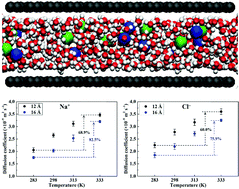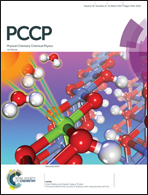Temperature dependence of ion diffusion coefficients in NaCl electrolyte confined within graphene nanochannels†
Abstract
The behavior of ion diffusion in nano-confined spaces and its temperature dependence provide important fundamental information about electric double-layer capacitors (EDLCs) employing nano-sized active materials. In this work, the ion diffusion coefficients of NaCl electrolyte confined within neutral and charged graphene nanochannels at different temperatures are investigated using molecular dynamics simulations. The results show that ions confined in neutral nanochannels diffuse faster (along the graphene surfaces) than those in bulk solution, which could be attributed to the relatively smaller concentration in confined spaces and the solvophobic nature of graphene surfaces. In charged nanochannels where the electrostatic interactions between counter-ions and charged channel surfaces govern the motion of ions, the diffusion coefficients are found to be lower than those in the neutral counterparts. The increase of temperature will lead to enhanced vibrant thermal motion of ions. Due to the significant role of ion–surface interactions, ion diffusion coefficients in nano-confined spaces are more stable, that is, insensitive to the temperature variation, than those in bulk solution. The electrical conductivity is further estimated using the Nernst–Einstein equation. The findings of the current work could provide basic data and information for research studies on the thermal effects of graphene-based EDLCs.



 Please wait while we load your content...
Please wait while we load your content...